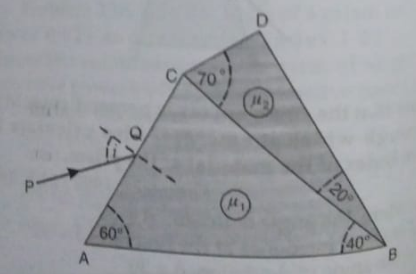A prism of refractive index μ1 and another prism of refractive index μ2 are struck together without a gap as shown in Fig.3.17.
 .
.
The ngles of the prisms are shown .μ1 and μ2 depend on δ,the wavelength of light according to
μ1=1.20+10.8×104δ2 and μ2=1.45+1.8×104δ2,
where δ is in nm.
Calculate the wavelength δ0 for which rays incident at any angle on the interface BC pass through without bending at that interrface.Solution in Punjabi
Step by step video & image solution for A prism of refractive index mu_1 and another prism of refractive index mu_2 are struck together without a gap as shown in Fig.3.17..The ngles of the prisms are shown .mu_1 and mu_2 depend on delta,the wavelength of light according to mu_1=1.20 +(10.8 xx 10^4)/(delta^2) and mu_2 = 1.45 + (1.8 xx 10^4)/(delta^2),where delta is in nm.Calculate the wavelength delta_0 for which rays incident at any angle on the interface BC pass through without bending at that interrface. by Physics experts to help you in doubts & scoring excellent marks in Class 12 exams.
Topper's Solved these Questions
- BOOK - MODERN PUBLICATIONCHAPTER - DISPERSIONEXERCISE - EXERCISE54videos
DISPERSION
- BOOK - MODERN PUBLICATIONCHAPTER - Diffraction of LightEXERCISE - EXERCISE65videos
Diffraction of Light
- BOOK - MODERN PUBLICATIONCHAPTER - ELECTRIC CURRENT. RESISTANCE AND E.M.FEXERCISE - EXERCISE64videos
ELECTRIC CURRENT. RESISTANCE AND E.M.F
Similar Questions
For a prism prove that
A+δ=i+e02:05View SolutionWhat is diffraction of light?
01:34View SolutionWhat is drift velocity of electrons? How do you explain the flow of current in a conductor based on this?
03:01View SolutionWhat happens to the frequency, wavelength and speed of light that crosses from a medium with index of refraction mu_1 to one with index of refraction mu_2 ?
04:12View SolutionPath of ray of light passing through three liquids of refractive indices μ1,μ2,μ3 is as shown in Fig. Which liquid has the smallest index of refraction ?
 .02:46View Solution
.02:46View SolutionA thin prism of angle 15∘ made of glass of refractive index μ1=1.5 is combined with another prism of glass of refractive index μ2=1.75. The combination of the prisms produces dispersion without deviation. The angle of the second prism should be
03:19View SolutionA double convex lens, made from a material of refractive index mu_1 , is immersed in a liquid of refractive index mu_2 , where mu_2 gt mu_1 . What change, if any, would occur in the nature of the lens?
01:58View SolutionA prism of refractive index mu_1 = 1.42 and prism angle 10° is arranged with another prism of refractive index mu_2 = 1.7. If this combination gives the dispersion without deviation, then what should be the prism angle of second prism?
02:30View SolutionA convex lens made of a material of refractive index μ1 , is kept in a medium of refractive index μ2, Parallel rays of light are incident on the lens. Complete the pathof rays of light emerging from the convex lens if μ1=μ2.
03:33View SolutionA convex lens made of a material of refractive index 'mu_1' is kept in a medium of refractive index μ2, Parallel rays of light are incident on the lens. Complete the pathof rays of light emerging fromthe convex lens if μ1<μ2.
10:25View SolutionA convex lens made of a material of refractive index μ1 is kept ih a medium of refractive index μ2, Parallel rays of light are incident on the lens. Complete the path of rays of light emerging fromthe convex lens if μ1>μ2.
03:51View SolutionWhat happens to the frequency, wavelength and speed of light that crosses from a medium with index of refraction mu_1 to one with index of refraction mu_2 ?
02:05View Solutionअपवर्तनांक μ1=1.5 के काँच से बने 15∘ का कोण एक पतला प्रिज़्म , अपवर्तनांक μ2=1.75 के काँच के एक अन्य प्रिज़्म के साथ जोड़ा जाता है। प्रिज़्म का संयोजन विचलन के बिना विक्षेपण उत्पन्न करता है। दूसरे प्रिज़्म का कोण होना चाहिए:
03:24View SolutionA prism of refractive index n_(1) & another prism of reactive index n_(2) are stuck together without a gap as shown in the figure.The angle of the prisms are as shown. n_(1)&n_(2) depend on lambda ,the wavelength of light according to n_(1)=1.20+(10.8xx10^(4))/(lambda^(2)) & n_(2)=1.45+(1.80xx10^(4))/(lambda^(2)) where lambda is in nm. (i)Calculate the wavelength lambda_(0) for which rays incident at any angle on the interface BC pass through without bending at that interface.
04:31View SolutionA double convex lens made from a material of refractive index mu_1 is immersed in a liquid of refactive index mu_2 where mu_2 > mu_1 . What change, if any, would occur in the nature of the lens?
04:50View SolutionA ray of light travelling in a medium of refractive index mu_1 is incident obliquely at the boundary of a medium of refractive index mu_2 . The ray may reflect back totally only when u_1 is _____ mu_2 .
10:53View Solution

